| Listing 1 - 10 of 21 | << page >> |
Sort by
|
Book
ISBN: 140088246X Year: 2016 Publisher: Princeton, NJ : Princeton University Press,
Abstract | Keywords | Export | Availability | Bookmark
 Loading...
Loading...Choose an application
- Reference Manager
- EndNote
- RefWorks (Direct export to RefWorks)
This book describes an invariant, l, of oriented rational homology 3-spheres which is a generalization of work of Andrew Casson in the integer homology sphere case. Let R(X) denote the space of conjugacy classes of representations of p(X) into SU(2). Let (W,W,F) be a Heegaard splitting of a rational homology sphere M. Then l(M) is declared to be an appropriately defined intersection number of R(W) and R(W) inside R(F). The definition of this intersection number is a delicate task, as the spaces involved have singularities. A formula describing how l transforms under Dehn surgery is proved. The formula involves Alexander polynomials and Dedekind sums, and can be used to give a rather elementary proof of the existence of l. It is also shown that when M is a Z-homology sphere, l(M) determines the Rochlin invariant of M.
Three-manifolds (Topology) --- Invariants. --- Absolute value. --- Andrew Casson. --- Basis (linear algebra). --- Cohomology. --- Dan Freed. --- Dehn surgery. --- Dehn twist. --- Determinant. --- Diagram (category theory). --- Disk (mathematics). --- Elementary proof. --- Fundamental group. --- General position. --- Heegaard splitting. --- Homology sphere. --- Identity matrix. --- Inner product space. --- Lie group. --- Mathematical sciences. --- Morris Hirsch. --- Normal bundle. --- Scientific notation. --- Sequence. --- Surjective function. --- Symplectic geometry. --- Theorem. --- Topology.
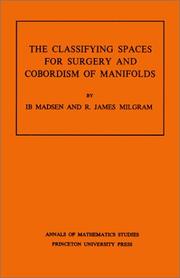
ISBN: 0691082251 069108226X 1400881471 Year: 1979 Publisher: Princeton : Tokyo : Princeton University Press Tokyo university press,
Abstract | Keywords | Export | Availability | Bookmark
 Loading...
Loading...Choose an application
- Reference Manager
- EndNote
- RefWorks (Direct export to RefWorks)
Beginning with a general discussion of bordism, Professors Madsen and Milgram present the homotopy theory of the surgery classifying spaces and the classifying spaces for the various required bundle theories. The next part covers more recent work on the maps between these spaces and the properties of the PL and Top characteristic classes, and includes integrality theorems for topological and PL manifolds. Later chapters treat the integral cohomology of BPL and Btop. The authors conclude with a discussion of the PL and topological cobordism rings and a construction of the torsion-free generators.
Algebraic topology --- 515.16 --- Classifying spaces --- Cobordism theory --- Manifolds (Mathematics) --- Surgery (Topology) --- Differential topology --- Homotopy equivalences --- Topology --- Geometry, Differential --- Spaces, Classifying --- Fiber bundles (Mathematics) --- Fiber spaces (Mathematics) --- Topology of manifolds --- Classifying spaces. --- Cobordism theory. --- Manifolds (Mathematics). --- Surgery (Topology). --- 515.16 Topology of manifolds --- Bijection. --- Calculation. --- Characteristic class. --- Classification theorem. --- Classifying space. --- Closed manifold. --- Cobordism. --- Coefficient. --- Cohomology. --- Commutative diagram. --- Commutative property. --- Complex projective space. --- Connected sum. --- Corollary. --- Cup product. --- Diagram (category theory). --- Differentiable manifold. --- Disjoint union. --- Disk (mathematics). --- Effective method. --- Eilenberg–Moore spectral sequence. --- Elaboration. --- Equivalence class. --- Exact sequence. --- Exterior algebra. --- Fiber bundle. --- Fibration. --- Function composition. --- H-space. --- Homeomorphism. --- Homomorphism. --- Homotopy fiber. --- Homotopy group. --- Homotopy. --- Hopf algebra. --- Iterative method. --- Loop space. --- Manifold. --- Massey product. --- N-sphere. --- Normal bundle. --- Obstruction theory. --- Pairing. --- Permutation. --- Piecewise linear manifold. --- Piecewise linear. --- Polynomial. --- Prime number. --- Projective space. --- Sequence. --- Simply connected space. --- Special case. --- Spin structure. --- Steenrod algebra. --- Subset. --- Summation. --- Tensor product. --- Theorem. --- Topological group. --- Topological manifold. --- Topology. --- Total order. --- Variétés topologiques --- Topologie differentielle
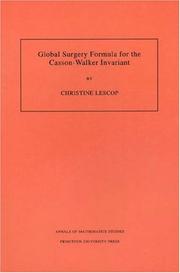
ISBN: 0691021333 1400865158 9781400865154 9780691021331 0691021325 9780691021324 Year: 1996 Volume: 140 Publisher: Princeton, New Jersey : Princeton University Press,
Abstract | Keywords | Export | Availability | Bookmark
 Loading...
Loading...Choose an application
- Reference Manager
- EndNote
- RefWorks (Direct export to RefWorks)
This book presents a new result in 3-dimensional topology. It is well known that any closed oriented 3-manifold can be obtained by surgery on a framed link in S 3. In Global Surgery Formula for the Casson-Walker Invariant, a function F of framed links in S 3 is described, and it is proven that F consistently defines an invariant, lamda (l), of closed oriented 3-manifolds. l is then expressed in terms of previously known invariants of 3-manifolds. For integral homology spheres, l is the invariant introduced by Casson in 1985, which allowed him to solve old and famous questions in 3-dimensional topology. l becomes simpler as the first Betti number increases. As an explicit function of Alexander polynomials and surgery coefficients of framed links, the function F extends in a natural way to framed links in rational homology spheres. It is proven that F describes the variation of l under any surgery starting from a rational homology sphere. Thus F yields a global surgery formula for the Casson invariant.
Chirurgie (Topologie) --- Drie-menigvuldigheden (Topologie) --- Heelkunde (Topologie) --- Surgery (Topology) --- Three-manifolds (Topology) --- Trois-variétés (Topologie) --- 3-manifolds (Topology) --- Manifolds, Three dimensional (Topology) --- Three-dimensional manifolds (Topology) --- Low-dimensional topology --- Topological manifolds --- Differential topology --- Homotopy equivalences --- Manifolds (Mathematics) --- Topology --- 515.16 --- 515.16 Topology of manifolds --- Topology of manifolds --- 3-manifold. --- Addition. --- Alexander polynomial. --- Ambient isotopy. --- Betti number. --- Casson invariant. --- Change of basis. --- Change of variables. --- Cobordism. --- Coefficient. --- Combination. --- Combinatorics. --- Computation. --- Conjugacy class. --- Connected component (graph theory). --- Connected space. --- Connected sum. --- Cup product. --- Determinant. --- Diagram (category theory). --- Disk (mathematics). --- Empty set. --- Exterior (topology). --- Fiber bundle. --- Fibration. --- Function (mathematics). --- Fundamental group. --- Homeomorphism. --- Homology (mathematics). --- Homology sphere. --- Homotopy sphere. --- Indeterminate (variable). --- Integer. --- Klein bottle. --- Knot theory. --- Manifold. --- Morphism. --- Notation. --- Orientability. --- Permutation. --- Polynomial. --- Prime number. --- Projective plane. --- Scientific notation. --- Seifert surface. --- Sequence. --- Summation. --- Symmetrization. --- Taylor series. --- Theorem. --- Topology. --- Tubular neighborhood. --- Unlink.

ISBN: 0691085773 1306986230 0691602891 0691632340 1400861063 9780691085777 Year: 1990 Volume: 39 Publisher: Princeton, N.J. Princeton University Press
Abstract | Keywords | Export | Availability | Bookmark
 Loading...
Loading...Choose an application
- Reference Manager
- EndNote
- RefWorks (Direct export to RefWorks)
One of the great achievements of contemporary mathematics is the new understanding of four dimensions. Michael Freedman and Frank Quinn have been the principals in the geometric and topological development of this subject, proving the Poincar and Annulus conjectures respectively. Recognition for this work includes the award of the Fields Medal of the International Congress of Mathematicians to Freedman in 1986. In Topology of 4-Manifolds these authors have collaborated to give a complete and accessible account of the current state of knowledge in this field. The basic material has been considerably simplified from the original publications, and should be accessible to most graduate students. The advanced material goes well beyond the literature; nearly one-third of the book is new. This work is indispensable for any topologist whose work includes four dimensions. It is a valuable reference for geometers and physicists who need an awareness of the topological side of the field.Originally published in 1990.The Princeton Legacy Library uses the latest print-on-demand technology to again make available previously out-of-print books from the distinguished backlist of Princeton University Press. These editions preserve the original texts of these important books while presenting them in durable paperback and hardcover editions. The goal of the Princeton Legacy Library is to vastly increase access to the rich scholarly heritage found in the thousands of books published by Princeton University Press since its founding in 1905.
Differential topology --- Four-manifolds (Topology) --- Trois-variétés (Topologie) --- Vier-menigvuldigheden (Topologie) --- 4-dimensional manifolds (Topology) --- 4-manifolds (Topology) --- Four dimensional manifolds (Topology) --- Manifolds, Four dimensional --- Low-dimensional topology --- Topological manifolds --- 4-manifold. --- Ambient isotopy. --- Annulus theorem. --- Automorphism. --- Baire category theorem. --- Bilinear form. --- Boundary (topology). --- CW complex. --- Category of manifolds. --- Central series. --- Characterization (mathematics). --- Cohomology. --- Commutative diagram. --- Commutative property. --- Commutator subgroup. --- Compactification (mathematics). --- Conformal geometry. --- Connected sum. --- Connectivity (graph theory). --- Cyclic group. --- Diagram (category theory). --- Diameter. --- Diffeomorphism. --- Differentiable manifold. --- Differential geometry. --- Dimension. --- Disk (mathematics). --- Duality (mathematics). --- Eigenvalues and eigenvectors. --- Embedding problem. --- Embedding. --- Equivariant map. --- Fiber bundle. --- Four-dimensional space. --- Fundamental group. --- General position. --- Geometry. --- H-cobordism. --- Handlebody. --- Hauptvermutung. --- Homeomorphism. --- Homology (mathematics). --- Homology sphere. --- Homomorphism. --- Homotopy group. --- Homotopy sphere. --- Homotopy. --- Hurewicz theorem. --- Hyperbolic geometry. --- Hyperbolic group. --- Hyperbolic manifold. --- Identity matrix. --- Intermediate value theorem. --- Intersection (set theory). --- Intersection curve. --- Intersection form (4-manifold). --- Intersection number (graph theory). --- Intersection number. --- J-homomorphism. --- Knot theory. --- Lefschetz duality. --- Line–line intersection. --- Manifold. --- Mapping cylinder. --- Mathematical induction. --- Metric space. --- Metrization theorem. --- Module (mathematics). --- Normal bundle. --- Parametrization. --- Parity (mathematics). --- Product topology. --- Pullback (differential geometry). --- Regular homotopy. --- Ring homomorphism. --- Rotation number. --- Seifert–van Kampen theorem. --- Sesquilinear form. --- Set (mathematics). --- Simply connected space. --- Smooth structure. --- Special case. --- Spin structure. --- Submanifold. --- Subset. --- Support (mathematics). --- Tangent bundle. --- Tangent space. --- Tensor product. --- Theorem. --- Topological category. --- Topological manifold. --- Transversal (geometry). --- Transversality (mathematics). --- Transversality theorem. --- Uniqueness theorem. --- Unit disk. --- Vector bundle. --- Whitehead torsion. --- Whitney disk.
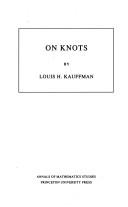
ISBN: 0691084343 0691084351 1400882133 9780691084343 Year: 1987 Volume: 115 Publisher: Princeton : Princeton University Press,
Abstract | Keywords | Export | Availability | Bookmark
 Loading...
Loading...Choose an application
- Reference Manager
- EndNote
- RefWorks (Direct export to RefWorks)
On Knots is a journey through the theory of knots, starting from the simplest combinatorial ideas--ideas arising from the representation of weaving patterns. From this beginning, topological invariants are constructed directly: first linking numbers, then the Conway polynomial and skein theory. This paves the way for later discussion of the recently discovered Jones and generalized polynomials. The central chapter, Chapter Six, is a miscellany of topics and recreations. Here the reader will find the quaternions and the belt trick, a devilish rope trick, Alhambra mosaics, Fibonacci trees, the topology of DNA, and the author's geometric interpretation of the generalized Jones Polynomial.Then come branched covering spaces, the Alexander polynomial, signature theorems, the work of Casson and Gordon on slice knots, and a chapter on knots and algebraic singularities.The book concludes with an appendix about generalized polynomials.
Knot theory --- Knots (Topology) --- Low-dimensional topology --- Knot theory. --- Algebraic topology --- 3-sphere. --- Addition theorem. --- Addition. --- Alexander polynomial. --- Algebraic variety. --- Algorithm. --- Ambient isotopy. --- Arf invariant. --- Basepoint. --- Bijection. --- Bilinear form. --- Borromean rings. --- Bracket polynomial. --- Braid group. --- Branched covering. --- Chiral knot. --- Chromatic polynomial. --- Cobordism. --- Codimension. --- Combination. --- Combinatorics. --- Complex analysis. --- Concentric. --- Conjecture. --- Connected sum. --- Conway polynomial (finite fields). --- Counting. --- Covering space. --- Cyclic group. --- Dense set. --- Determinant. --- Diagram (category theory). --- Diffeomorphism. --- Dimension. --- Disjoint union. --- Disk (mathematics). --- Dual graph. --- Elementary algebra. --- Embedding. --- Enumeration. --- Existential quantification. --- Exotic sphere. --- Fibration. --- Formal power series. --- Fundamental group. --- Geometric topology. --- Geometry and topology. --- Geometry. --- Group action. --- Homotopy. --- Integer. --- Intersection form (4-manifold). --- Isolated singularity. --- Jones polynomial. --- Knot complement. --- Knot group. --- Laws of Form. --- Lens space. --- Linking number. --- Manifold. --- Module (mathematics). --- Morwen Thistlethwaite. --- Normal bundle. --- Notation. --- Obstruction theory. --- Operator algebra. --- Pairing. --- Parity (mathematics). --- Partition function (mathematics). --- Planar graph. --- Point at infinity. --- Polynomial ring. --- Polynomial. --- Quantity. --- Rectangle. --- Reidemeister move. --- Remainder. --- Root of unity. --- Saddle point. --- Seifert surface. --- Singularity theory. --- Slice knot. --- Special case. --- Statistical mechanics. --- Substructure. --- Summation. --- Symmetry. --- Theorem. --- Three-dimensional space (mathematics). --- Topological space. --- Torus knot. --- Trefoil knot. --- Tubular neighborhood. --- Underpinning. --- Unknot. --- Variable (mathematics). --- Whitehead link. --- Wild knot. --- Writhe. --- Variétés topologiques --- Topologie combinatoire --- Theorie des noeuds
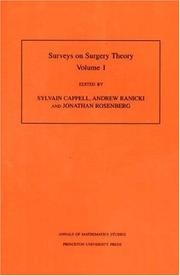
ISBN: 0691049386 0691088152 1322055211 1400865190 0691049378 1322063281 1400865212 0691088144 9781400865192 9780691049380 9780691049373 9781400865215 9780691088150 9780691088150 9780691088143 Year: 2001 Volume: 145,149 Publisher: Princeton, New Jersey ; Oxfordshire, England : Princeton University Press,
Abstract | Keywords | Export | Availability | Bookmark
 Loading...
Loading...Choose an application
- Reference Manager
- EndNote
- RefWorks (Direct export to RefWorks)
Surgery theory, the basis for the classification theory of manifolds, is now about forty years old. The sixtieth birthday (on December 14, 1996) of C.T.C. Wall, a leading member of the subject's founding generation, led the editors of this volume to reflect on the extraordinary accomplishments of surgery theory as well as its current enormously varied interactions with algebra, analysis, and geometry. Workers in many of these areas have often lamented the lack of a single source surveying surgery theory and its applications. Because no one person could write such a survey, the editors asked a variety of experts to report on the areas of current interest. This is the second of two volumes resulting from that collective effort. It will be useful to topologists, to other interested researchers, and to advanced students. The topics covered include current applications of surgery, Wall's finiteness obstruction, algebraic surgery, automorphisms and embeddings of manifolds, surgery theoretic methods for the study of group actions and stratified spaces, metrics of positive scalar curvature, and surgery in dimension four. In addition to the editors, the contributors are S. Ferry, M. Weiss, B. Williams, T. Goodwillie, J. Klein, S. Weinberger, B. Hughes, S. Stolz, R. Kirby, L. Taylor, and F. Quinn.
Chirurgie (Topologie) --- Heelkunde (Topologie) --- Surgery (Topology) --- Differential topology --- Homotopy equivalences --- Manifolds (Mathematics) --- Topology --- Algebraic topology (object). --- Algebraic topology. --- Ambient isotopy. --- Assembly map. --- Atiyah–Hirzebruch spectral sequence. --- Atiyah–Singer index theorem. --- Automorphism. --- Banach algebra. --- Borsuk–Ulam theorem. --- C*-algebra. --- CW complex. --- Calculation. --- Category of manifolds. --- Characterization (mathematics). --- Chern class. --- Cobordism. --- Codimension. --- Cohomology. --- Compactification (mathematics). --- Conjecture. --- Contact geometry. --- Degeneracy (mathematics). --- Diagram (category theory). --- Diffeomorphism. --- Differentiable manifold. --- Differential geometry. --- Dirac operator. --- Disk (mathematics). --- Donaldson theory. --- Duality (mathematics). --- Embedding. --- Epimorphism. --- Excision theorem. --- Exponential map (Riemannian geometry). --- Fiber bundle. --- Fibration. --- Fundamental group. --- Group action. --- Group homomorphism. --- H-cobordism. --- Handle decomposition. --- Handlebody. --- Homeomorphism group. --- Homeomorphism. --- Homology (mathematics). --- Homomorphism. --- Homotopy extension property. --- Homotopy fiber. --- Homotopy group. --- Homotopy. --- Hypersurface. --- Intersection form (4-manifold). --- Intersection homology. --- Isomorphism class. --- K3 surface. --- L-theory. --- Limit (category theory). --- Manifold. --- Mapping cone (homological algebra). --- Mapping cylinder. --- Mostow rigidity theorem. --- Orthonormal basis. --- Parallelizable manifold. --- Poincaré conjecture. --- Product metric. --- Projection (linear algebra). --- Pushout (category theory). --- Quaternionic projective space. --- Quotient space (topology). --- Resolution of singularities. --- Ricci curvature. --- Riemann surface. --- Riemannian geometry. --- Riemannian manifold. --- Ring homomorphism. --- Scalar curvature. --- Semisimple algebra. --- Sheaf (mathematics). --- Sign (mathematics). --- Special case. --- Sub"ient. --- Subgroup. --- Submanifold. --- Support (mathematics). --- Surgery exact sequence. --- Surgery obstruction. --- Surgery theory. --- Symplectic geometry. --- Symplectic vector space. --- Theorem. --- Topological conjugacy. --- Topological manifold. --- Topology. --- Transversality (mathematics). --- Transversality theorem. --- Vector bundle. --- Waldhausen category. --- Whitehead torsion. --- Whitney embedding theorem. --- Yamabe invariant.
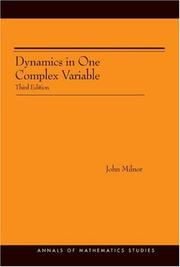
ISBN: 9780691124889 9780691124872 0691124884 0691124876 9786613001481 1400835534 1283001489 9781400835539 9781283001489 6613001481 Year: 2006 Publisher: Princeton Princeton University Press
Abstract | Keywords | Export | Availability | Bookmark
 Loading...
Loading...Choose an application
- Reference Manager
- EndNote
- RefWorks (Direct export to RefWorks)
This volume studies the dynamics of iterated holomorphic mappings from a Riemann surface to itself, concentrating on the classical case of rational maps of the Riemann sphere. This subject is large and rapidly growing. These lectures are intended to introduce some key ideas in the field, and to form a basis for further study. The reader is assumed to be familiar with the rudiments of complex variable theory and of two-dimensional differential geometry, as well as some basic topics from topology. This third edition contains a number of minor additions and improvements: A historical survey has been added, the definition of Lattés map has been made more inclusive, and the écalle-Voronin theory of parabolic points is described. The résidu itératif is studied, and the material on two complex variables has been expanded. Recent results on effective computability have been added, and the references have been expanded and updated. Written in his usual brilliant style, the author makes difficult mathematics look easy. This book is a very accessible source for much of what has been accomplished in the field.
Functions of complex variables --- Holomorphic mappings --- Riemann surfaces --- Fonctions d'une variable complexe --- Applications holomorphes --- Riemann, surfaces de --- Holomorphic mappings. --- Mappings, Holomorphic --- Functions of complex variables. --- Riemann surfaces. --- Surfaces, Riemann --- Functions --- Functions of several complex variables --- Mappings (Mathematics) --- Complex variables --- Elliptic functions --- Functions of real variables --- Absolute value. --- Addition. --- Algebraic equation. --- Attractor. --- Automorphism. --- Beltrami equation. --- Blaschke product. --- Boundary (topology). --- Branched covering. --- Coefficient. --- Compact Riemann surface. --- Compact space. --- Complex analysis. --- Complex number. --- Complex plane. --- Computation. --- Connected component (graph theory). --- Connected space. --- Constant function. --- Continued fraction. --- Continuous function. --- Coordinate system. --- Corollary. --- Covering space. --- Cross-ratio. --- Derivative. --- Diagram (category theory). --- Diameter. --- Diffeomorphism. --- Differentiable manifold. --- Disjoint sets. --- Disjoint union. --- Disk (mathematics). --- Division by zero. --- Equation. --- Euler characteristic. --- Existential quantification. --- Exponential map (Lie theory). --- Fundamental group. --- Harmonic function. --- Holomorphic function. --- Homeomorphism. --- Hyperbolic geometry. --- Inequality (mathematics). --- Integer. --- Inverse function. --- Irrational rotation. --- Iteration. --- Jordan curve theorem. --- Julia set. --- Lebesgue measure. --- Lecture. --- Limit point. --- Line segment. --- Linear map. --- Linearization. --- Mandelbrot set. --- Mathematical analysis. --- Maximum modulus principle. --- Metric space. --- Monotonic function. --- Montel's theorem. --- Normal family. --- Open set. --- Orbifold. --- Parameter space. --- Parameter. --- Periodic point. --- Point at infinity. --- Polynomial. --- Power series. --- Proper map. --- Quadratic function. --- Rational approximation. --- Rational function. --- Rational number. --- Real number. --- Riemann sphere. --- Riemann surface. --- Root of unity. --- Rotation number. --- Schwarz lemma. --- Scientific notation. --- Sequence. --- Simply connected space. --- Special case. --- Subgroup. --- Subsequence. --- Subset. --- Summation. --- Tangent space. --- Theorem. --- Topological space. --- Topology. --- Uniform convergence. --- Uniformization theorem. --- Unit circle. --- Unit disk. --- Upper half-plane. --- Winding number.
Book
ISBN: 168015897X 1282458205 1282935755 9786612458200 9786612935756 1400831474 0691141959 9780691141954 9781400831470 9781680158977 9781282458208 9781282935754 6612458208 6612935758 Year: 2009 Publisher: Princeton, NJ : Princeton University Press,
Abstract | Keywords | Export | Availability | Bookmark
 Loading...
Loading...Choose an application
- Reference Manager
- EndNote
- RefWorks (Direct export to RefWorks)
This self-contained introduction to the distributed control of robotic networks offers a distinctive blend of computer science and control theory. The book presents a broad set of tools for understanding coordination algorithms, determining their correctness, and assessing their complexity; and it analyzes various cooperative strategies for tasks such as consensus, rendezvous, connectivity maintenance, deployment, and boundary estimation. The unifying theme is a formal model for robotic networks that explicitly incorporates their communication, sensing, control, and processing capabilities--a model that in turn leads to a common formal language to describe and analyze coordination algorithms. Written for first- and second-year graduate students in control and robotics, the book will also be useful to researchers in control theory, robotics, distributed algorithms, and automata theory. The book provides explanations of the basic concepts and main results, as well as numerous examples and exercises. Self-contained exposition of graph-theoretic concepts, distributed algorithms, and complexity measures for processor networks with fixed interconnection topology and for robotic networks with position-dependent interconnection topology Detailed treatment of averaging and consensus algorithms interpreted as linear iterations on synchronous networks Introduction of geometric notions such as partitions, proximity graphs, and multicenter functions Detailed treatment of motion coordination algorithms for deployment, rendezvous, connectivity maintenance, and boundary estimation
Robotics. --- Computer algorithms. --- Robots --- Automation --- Machine theory --- Robot control --- Robotics --- Algorithms --- Control systems. --- Computer algorithms --- Control systems --- 1-center problem. --- Adjacency matrix. --- Aggregate function. --- Algebraic connectivity. --- Algebraic topology (object). --- Algorithm. --- Analysis of algorithms. --- Approximation algorithm. --- Asynchronous system. --- Bellman–Ford algorithm. --- Bifurcation theory. --- Bounded set (topological vector space). --- Calculation. --- Cartesian product. --- Centroid. --- Chebyshev center. --- Circulant matrix. --- Circumscribed circle. --- Cluster analysis. --- Combinatorial optimization. --- Combinatorics. --- Communication complexity. --- Computation. --- Computational complexity theory. --- Computational geometry. --- Computational model. --- Computer simulation. --- Computer vision. --- Connected component (graph theory). --- Connectivity (graph theory). --- Consensus (computer science). --- Control function (econometrics). --- Differentiable function. --- Dijkstra's algorithm. --- Dimensional analysis. --- Directed acyclic graph. --- Directed graph. --- Discrete time and continuous time. --- Disk (mathematics). --- Distributed algorithm. --- Doubly stochastic matrix. --- Dynamical system. --- Eigenvalues and eigenvectors. --- Estimation. --- Euclidean space. --- Function composition. --- Hybrid system. --- Information theory. --- Initial condition. --- Instance (computer science). --- Invariance principle (linguistics). --- Invertible matrix. --- Iteration. --- Iterative method. --- Kinematics. --- Laplacian matrix. --- Leader election. --- Linear dynamical system. --- Linear interpolation. --- Linear programming. --- Lipschitz continuity. --- Lyapunov function. --- Markov chain. --- Mathematical induction. --- Mathematical optimization. --- Mobile robot. --- Motion planning. --- Multi-agent system. --- Network model. --- Network topology. --- Norm (mathematics). --- Numerical integration. --- Optimal control. --- Optimization problem. --- Parameter (computer programming). --- Partition of a set. --- Percolation theory. --- Permutation matrix. --- Polytope. --- Proportionality (mathematics). --- Quantifier (logic). --- Quantization (signal processing). --- Robustness (computer science). --- Scientific notation. --- Sensor. --- Set (mathematics). --- Simply connected space. --- Simulation. --- Simultaneous equations. --- State space. --- State variable. --- Stochastic matrix. --- Stochastic. --- Strongly connected component. --- Synchronous network. --- Theorem. --- Time complexity. --- Topology. --- Variable (mathematics). --- Vector field.

ISBN: 0691002576 1400865182 9781400865185 9780691002583 9780691002576 0691002584 9780691002583 Year: 1998 Publisher: Princeton, New Jersey : Princeton University Press,
Abstract | Keywords | Export | Availability | Bookmark
 Loading...
Loading...Choose an application
- Reference Manager
- EndNote
- RefWorks (Direct export to RefWorks)
In 1920, Pierre Fatou expressed the conjecture that--except for special cases--all critical points of a rational map of the Riemann sphere tend to periodic orbits under iteration. This conjecture remains the main open problem in the dynamics of iterated maps. For the logistic family x- ax(1-x), it can be interpreted to mean that for a dense set of parameters "a," an attracting periodic orbit exists. The same question appears naturally in science, where the logistic family is used to construct models in physics, ecology, and economics. In this book, Jacek Graczyk and Grzegorz Swiatek provide a rigorous proof of the Real Fatou Conjecture. In spite of the apparently elementary nature of the problem, its solution requires advanced tools of complex analysis. The authors have written a self-contained and complete version of the argument, accessible to someone with no knowledge of complex dynamics and only basic familiarity with interval maps. The book will thus be useful to specialists in real dynamics as well as to graduate students.
Geodesics (Mathematics) --- Polynomials. --- Mappings (Mathematics) --- Maps (Mathematics) --- Functions --- Functions, Continuous --- Topology --- Transformations (Mathematics) --- Algebra --- Geometry, Differential --- Global analysis (Mathematics) --- Mathematics --- Absolute value. --- Affine transformation. --- Algebraic function. --- Analytic continuation. --- Analytic function. --- Arithmetic. --- Automorphism. --- Big O notation. --- Bounded set (topological vector space). --- C0. --- Calculation. --- Canonical map. --- Change of variables. --- Chebyshev polynomials. --- Combinatorics. --- Commutative property. --- Complex number. --- Complex plane. --- Complex quadratic polynomial. --- Conformal map. --- Conjecture. --- Conjugacy class. --- Conjugate points. --- Connected component (graph theory). --- Connected space. --- Continuous function. --- Corollary. --- Covering space. --- Critical point (mathematics). --- Dense set. --- Derivative. --- Diffeomorphism. --- Dimension. --- Disjoint sets. --- Disjoint union. --- Disk (mathematics). --- Equicontinuity. --- Estimation. --- Existential quantification. --- Fibonacci. --- Functional equation. --- Fundamental domain. --- Generalization. --- Great-circle distance. --- Hausdorff distance. --- Holomorphic function. --- Homeomorphism. --- Homotopy. --- Hyperbolic function. --- Imaginary number. --- Implicit function theorem. --- Injective function. --- Integer. --- Intermediate value theorem. --- Interval (mathematics). --- Inverse function. --- Irreducible polynomial. --- Iteration. --- Jordan curve theorem. --- Julia set. --- Limit of a sequence. --- Linear map. --- Local diffeomorphism. --- Mathematical induction. --- Mathematical proof. --- Maxima and minima. --- Meromorphic function. --- Moduli (physics). --- Monomial. --- Monotonic function. --- Natural number. --- Neighbourhood (mathematics). --- Open set. --- Parameter. --- Periodic function. --- Periodic point. --- Phase space. --- Point at infinity. --- Polynomial. --- Projection (mathematics). --- Quadratic function. --- Quadratic. --- Quasiconformal mapping. --- Renormalization. --- Riemann sphere. --- Riemann surface. --- Schwarzian derivative. --- Scientific notation. --- Subsequence. --- Theorem. --- Theory. --- Topological conjugacy. --- Topological entropy. --- Topology. --- Union (set theory). --- Unit circle. --- Unit disk. --- Upper and lower bounds. --- Upper half-plane. --- Z0.
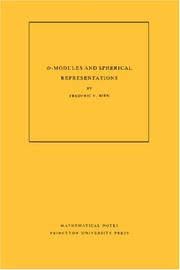
ISBN: 1400862078 9781400862078 0691025177 9780691608327 9780691025179 0691025177 0691608326 9780691608327 Year: 1990 Publisher: Princeton, New Jersey
Abstract | Keywords | Export | Availability | Bookmark
 Loading...
Loading...Choose an application
- Reference Manager
- EndNote
- RefWorks (Direct export to RefWorks)
The theory of D-modules deals with the algebraic aspects of differential equations. These are particularly interesting on homogeneous manifolds, since the infinitesimal action of a Lie algebra consists of differential operators. Hence, it is possible to attach geometric invariants, like the support and the characteristic variety, to representations of Lie groups. By considering D-modules on flag varieties, one obtains a simple classification of all irreducible admissible representations of reductive Lie groups. On the other hand, it is natural to study the representations realized by functions on pseudo-Riemannian symmetric spaces, i.e., spherical representations. The problem is then to describe the spherical representations among all irreducible ones, and to compute their multiplicities. This is the goal of this work, achieved fairly completely at least for the discrete series representations of reductive symmetric spaces. The book provides a general introduction to the theory of D-modules on flag varieties, and it describes spherical D-modules in terms of a cohomological formula. Using microlocalization of representations, the author derives a criterion for irreducibility. The relation between multiplicities and singularities is also discussed at length.Originally published in 1990.The Princeton Legacy Library uses the latest print-on-demand technology to again make available previously out-of-print books from the distinguished backlist of Princeton University Press. These editions preserve the original texts of these important books while presenting them in durable paperback and hardcover editions. The goal of the Princeton Legacy Library is to vastly increase access to the rich scholarly heritage found in the thousands of books published by Princeton University Press since its founding in 1905.
Differentiable manifolds. --- D-modules. --- Representations of groups. --- Lie groups. --- Groups, Lie --- Lie algebras --- Symmetric spaces --- Topological groups --- Group representation (Mathematics) --- Groups, Representation theory of --- Group theory --- Modules (Algebra) --- Differential manifolds --- Manifolds (Mathematics) --- Affine space. --- Algebraic cycle. --- Algebraic element. --- Analytic function. --- Annihilator (ring theory). --- Automorphism. --- Banach space. --- Base change. --- Big O notation. --- Bijection. --- Bilinear form. --- Borel subgroup. --- Cartan subalgebra. --- Cofibration. --- Cohomology. --- Commutative diagram. --- Commutative property. --- Commutator subgroup. --- Complexification (Lie group). --- Conjugacy class. --- Coproduct. --- Coset. --- Cotangent space. --- D-module. --- Derived category. --- Diagram (category theory). --- Differential operator. --- Dimension (vector space). --- Direct image functor. --- Discrete series representation. --- Disk (mathematics). --- Dot product. --- Double coset. --- Eigenfunction. --- Eigenvalues and eigenvectors. --- Endomorphism. --- Euler operator. --- Existential quantification. --- Fibration. --- Function space. --- Functor. --- G-module. --- Gelfand pair. --- Generic point. --- Hilbert space. --- Holomorphic function. --- Homomorphism. --- Hyperfunction. --- Ideal (ring theory). --- Infinitesimal character. --- Inner automorphism. --- Invertible sheaf. --- Irreducibility (mathematics). --- Irreducible representation. --- Levi decomposition. --- Lie algebra. --- Line bundle. --- Linear algebraic group. --- Linear space (geometry). --- Manifold. --- Maximal compact subgroup. --- Maximal torus. --- Metric space. --- Module (mathematics). --- Moment map. --- Morphism. --- Noetherian ring. --- Open set. --- Presheaf (category theory). --- Principal series representation. --- Projective line. --- Projective object. --- Projective space. --- Projective variety. --- Reductive group. --- Riemannian geometry. --- Riemann–Hilbert correspondence. --- Right inverse. --- Ring (mathematics). --- Root system. --- Satake diagram. --- Sheaf (mathematics). --- Sheaf of modules. --- Special case. --- Sphere. --- Square-integrable function. --- Sub"ient. --- Subalgebra. --- Subcategory. --- Subgroup. --- Summation. --- Surjective function. --- Symmetric space. --- Symplectic geometry. --- Tensor product. --- Theorem. --- Triangular matrix. --- Vector bundle. --- Volume form. --- Weyl group.
| Listing 1 - 10 of 21 | << page >> |
Sort by
|

 Search
Search Feedback
Feedback About
About Help
Help News
News